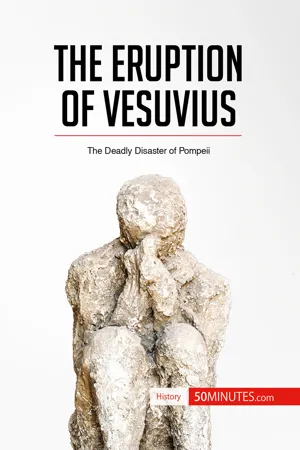
- English
- ePUB (mobile friendly)
- Available on iOS & Android
About this book
Keen to learn but short on time? Get to grips with the events of the eruption of Vesuvius in next to no time with this concise guide. 50Minutes.com provides a clear and engaging analysis of the eruption of Vesuvius. In the year 79, Pompeii was a lively resort town located on the slopes of Mount Vesuvius. Little did its residents know, the city was about to be struck by a natural disaster that would erase the city from the map forever. Remembered as one of the most terrible disasters of all time, the eruption of Mount Vesuvius took the lives of nearly all Pompeii's inhabitants and the city itself, covered in a thick layer of ash that would preserve these remains of ancient life for centuries to come. In just 50 minutes you will:
•Understand the historical and cultural context of the time before the eruption struck
•Learn more about the people who witnessed the disaster and how they described the terrible event
•Analyse the lasting impact the volcano's eruption had on Pompeii and the surrounding region ABOUT 50MINUTES.COM | History & Culture
50MINUTES.COM will enable you to quickly understand the main events, people, conflicts and discoveries from world history that have shaped the world we live in today. Our publications present the key information on a wide variety of topics in a quick and accessible way that is guaranteed to save you time on your journey of discovery.
Frequently asked questions
- Essential is ideal for learners and professionals who enjoy exploring a wide range of subjects. Access the Essential Library with 800,000+ trusted titles and best-sellers across business, personal growth, and the humanities. Includes unlimited reading time and Standard Read Aloud voice.
- Complete: Perfect for advanced learners and researchers needing full, unrestricted access. Unlock 1.4M+ books across hundreds of subjects, including academic and specialized titles. The Complete Plan also includes advanced features like Premium Read Aloud and Research Assistant.
Please note we cannot support devices running on iOS 13 and Android 7 or earlier. Learn more about using the app.
Information
THE DEATH AND REBIRTH OF POMPEII
24th AUGUST 79


Table of contents
- Title Page
- The Eruption of Vesuvius
- Context
- Biographies
- The death and rebirth of Pompeii
- The archaeological site and discoveries
- Summary
- Find out more
- Copyright